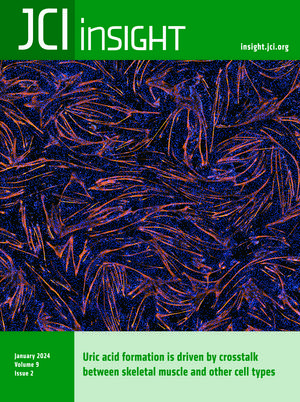组蛋白甲基转移酶混合行-白血病-1在糖尿病组织修复中通过notch信号驱动T细胞表型。
IF 6.3
1区 医学
Q1 MEDICINE, RESEARCH & EXPERIMENTAL
引用次数: 0
摘要
免疫细胞介导的炎症在正常组织再生过程中非常重要,但在糖尿病伤口中可能是病理性的。关于 CD4+T 细胞在正常或糖尿病伤口修复中的作用的文献有限,但已发现 CD4+TH17/Treg 细胞的失衡会促进其他糖尿病组织的炎症。在此,我们利用人体组织和小鼠转基因模型,发现组蛋白甲基转移酶 MLL1 通过 H3K4me3 机制直接调节 TH17 转录因子 RORγ,并增加 Notch 受体的表达和下游 Notch 信号转导。此外,我们还发现,Notch受体信号调节CD4+TH细胞分化,对正常伤口修复至关重要,CD4+T细胞中Notch通路上游介质或受体的缺失会导致伤口中CD4+TH细胞分化的丧失。在糖尿病患者中,MLL1和Notch受体信号在伤口CD4+TH细胞中上调,促使CD4+T细胞向TH17细胞表型发展。用MLL1小分子抑制剂(MI-2)处理糖尿病伤口CD4T细胞可显著减少CD4+TH17细胞和IL17A。这项研究首次确定了 MLL1 介导的正常和糖尿病伤口 TH17/Treg 平衡调节机制,并定义了 Notch 信号在伤口 CD4+T 细胞中的复杂作用,Notch 信号的增加或减少都会导致病理性伤口修复。治疗性靶向糖尿病 CD4+TH 细胞中的 MLL1 可能会通过调节 CD4+T 细胞分化来减少病理性炎症。本文章由计算机程序翻译,如有差异,请以英文原文为准。
The histone methyltransferase mixed-lineage-leukemia-1 drives T cell phenotype via notch signaling in diabetic tissue repair.
Immune cell mediated inflammation is important in normal tissue regeneration but can be pathologic in diabetic wounds. Limited literature exists on the role of CD4+T cells in normal or diabetic wound repair, however, the imbalance of CD4+TH17/Treg cells has been found to promote inflammation in other diabetic tissues. Here, using human tissue and murine transgenic models, we identified that the histone methyltransferase MLL1 directly regulates the TH17 transcription factor RORγ via an H3K4me3 mechanism and increases expression of Notch receptors and downstream Notch signaling. Further, we found that Notch receptor signaling regulates CD4+TH cell differentiation and is critical for normal wound repair, and loss of upstream Notch pathway mediators or receptors in CD4+T cells resulted in the loss of CD4+TH cell differentiation in wounds. In diabetes, MLL1 and Notch-receptor signaling were upregulated in wound CD4+TH cells, driving CD4+ T cells towards the TH17 cell phenotype. Treatment of diabetic wound CD4T cells with a small molecule inhibitor of MLL1 (MI-2) yielded a significant reduction in CD4+TH17 cells and IL17A. This is the first study to identify the MLL1-mediated mechanisms responsible for regulating the TH17/Treg balance in normal and diabetic wounds and define the complex role of Notch signaling in CD4+T cells in wounds, where increased or decreased Notch signaling both result in pathologic wound repair. Therapeutic targeting of MLL1 in diabetic CD4+TH cells may decrease pathologic inflammation through regulation of CD4+T cell differentiation.
求助全文
通过发布文献求助,成功后即可免费获取论文全文。
去求助
来源期刊

JCI insight
Medicine-General Medicine
CiteScore
13.70
自引率
1.20%
发文量
543
审稿时长
6 weeks
期刊介绍:
JCI Insight is a Gold Open Access journal with a 2022 Impact Factor of 8.0. It publishes high-quality studies in various biomedical specialties, such as autoimmunity, gastroenterology, immunology, metabolism, nephrology, neuroscience, oncology, pulmonology, and vascular biology. The journal focuses on clinically relevant basic and translational research that contributes to the understanding of disease biology and treatment. JCI Insight is self-published by the American Society for Clinical Investigation (ASCI), a nonprofit honor organization of physician-scientists founded in 1908, and it helps fulfill the ASCI's mission to advance medical science through the publication of clinically relevant research reports.
 求助内容:
求助内容: 应助结果提醒方式:
应助结果提醒方式:


